X-ray Crystallographic Structure of α-Helical Peptide Stabilized by Hydrocarbon Stapling at i,i + 1 Positions
Abstract
1. Introduction
2. Results and Discussion
3. Materials and Methods
3.1. General Procedure and Method
3.2. Synthesis of Unstapled Dipeptides 2–7
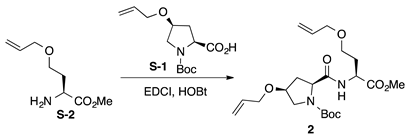





3.3. Synthesis of Stapled Dipeptides 1′–7′
3.4. Synthesis of Stapled Octapeptides 9 and 10
Supplementary Materials
Author Contributions
Funding
Institutional Review Board Statement
Informed Consent Statement
Data Availability Statement
Acknowledgments
Conflicts of Interest
References
- Moretto, A.; Crisma, M.; Formaggio, F.; Toniolo, C. Building a bridge between peptide chemistry and organic chemistry: Intramolecular macrocyclization reactions and supramolecular chemistry with helical peptide substrates. Biopolymers 2010, 94, 721–732. [Google Scholar] [CrossRef] [PubMed]
- Verdine, G.L.; Hilinski, G.J. Stapled peptides for intracellular drug targets. Methods Enzymol. 2012, 503, 3–33. [Google Scholar] [CrossRef] [PubMed]
- Cromm, P.M.; Spiegel, J.; Grossmann, T.N. Hydrocarbon stapled peptides as modulators of biological function. ACS Chem. Biol. 2015, 10, 1362–1375. [Google Scholar] [CrossRef] [PubMed]
- Moiola, M.; Memeo, M.G.; Quadrelli, P. Stapled Peptides—A Useful Improvement for Peptide-Based Drugs. Molecules 2019, 24, 3654. [Google Scholar] [CrossRef] [PubMed]
- Bozovičar, K.; Bratkovič, T. Small and Simple, yet Sturdy: Conformationally Constrained Peptides with Remarkable Properties. Int. J. Mol. Sci. 2021, 22, 1611. [Google Scholar] [CrossRef] [PubMed]
- Blackwell, H.E.; Grubbs, R.H. Highly efficient synthesis of covalently cross-linked peptide helices by ring-closing metathesis. Angew. Chem. Int. Ed. 1998, 37, 3281–3284. [Google Scholar] [CrossRef]
- Blackwell, H.E.; Sadowsky, J.D.; Howard, R.J.; Sampson, J.N.; Chao, J.A.; Steinmetz, W.E.; O’Leary, D.J.; Grubbs, R.H. Ring-closing metathesis of olefinic peptides: Design, synthesis, and structural characterization of macrocyclic helical peptides. J. Org. Chem. 2001, 66, 5291–5302. [Google Scholar] [CrossRef]
- Schafmeister, C.E.; Po, J.; Verdine, G.L. An all-hydrocarbon cross-linking system for enhancing the helicity and metabolic stability of peptides. J. Am. Chem. Soc. 2000, 122, 5891–5892. [Google Scholar] [CrossRef]
- Sawyer, T.K.; Partridge, A.W.; Kaan, H.Y.K.; Juang, Y.C.; Lim, S.; Johannes, C.; Yuen, T.Y.; Verma, C.; Kannan, S.; Aronica, P.; et al. Macrocyclic alpha helical peptide therapeutic modality: A perspective of learnings and challenges. Bioorg. Med. Chem. 2018, 26, 2807–2815. [Google Scholar] [CrossRef]
- Ali, A.M.; Atmaj, J.; Oosterwijk, N.V.; Groves, M.R.; Dömling, A. Stapled peptides inhibitors: A new window for target drug discovery. Comput. Struct. Biotechnol. J. 2019, 17, 263–281. [Google Scholar] [CrossRef] [PubMed]
- Hirano, M.; Saito, C.; Yokoo, H.; Goto, C.; Kawano, R.; Misawa, T.; Demizu, Y. Development of Antimicrobial Stapled Peptides Based on Magainin 2 Sequence. Molecules 2021, 26, 444. [Google Scholar] [CrossRef] [PubMed]
- Jochim, A.L.; Arora, P.S. Systematic analysis of helical protein interfaces reveals targets for synthetic inhibitors. ACS Chem. Biol. 2010, 5, 919–923. [Google Scholar] [CrossRef] [PubMed]
- Boal, A.K.; Guryanov, I.; Moretto, A.; Crisma, M.; Lanni, E.L.; Toniolo, C.; Grubbs, R.H.; O’Leary, D.J. Facile and E-selective intramolecular ring-closing metathesis reactions in 310-helical peptides: A 3D structural study. J. Am. Chem. Soc. 2007, 129, 6986–6987. [Google Scholar] [CrossRef] [PubMed]
- Kim, Y.-W.; Kutchukian, P.S.; Verdine, G.L. Introduction of all-hydrocarbon i,i+3 staples into α-helices via ring-closing olefin metathesis. Org. Lett. 2010, 12, 3046–3049. [Google Scholar] [CrossRef] [PubMed]
- Mangold, S.L.; O’Leary, D.J.; Grubbs, R.H. Z-Selective olefin metathesis on peptides: Investigation of side-chain influence, preorganization, and guidelines in substrate selection. J. Am. Chem. Soc. 2014, 136, 12469–12478. [Google Scholar] [CrossRef]
- Mangold, S.L.; Grubbs, R.H. Stereoselective synthesis of macrocyclic peptides via a dual olefin metathesis and ethenolysis approach. Chem. Sci. 2015, 6, 4561–4569. [Google Scholar] [CrossRef]
- Creighton, C.J.; Reitz, A.B. Synthesis of an eight-membered cyclic pseudo-dipeptide using ring closing metathesis. Org. Lett. 2001, 3, 893–895. [Google Scholar] [CrossRef]
- Islam, N.M.; Islam, M.S.; Hoque, M.A.; Kato, T.; Nishino, N.; Ito, A.; Yoshida, M. Bicyclic tetrapeptides as potent HDAC inhibitors: Effect of aliphatic loop position and hydrophobicity on inhibitory activity. Bioorg. Med. Chem. 2014, 22, 3862–3870. [Google Scholar] [CrossRef]
- Ueda, A.; Higuchi, M.; Sato, K.; Umeno, T.; Tanaka, M. Design and synthesis of helical N-terminal L-prolyl oligopeptides possessing hydrocarbon stapling. Molecules 2020, 25, 4667. [Google Scholar] [CrossRef]
- Hill, T.A.; Shepherd, N.E.; Diness, F.; Fairlie, D.P. Constraining cyclic peptides to mimic protein structure motifs. Angew. Chem. Int. Ed. 2014, 53, 13020–13041. [Google Scholar] [CrossRef]
- Paul, P.K.C.; Sukumar, M.; Bardi, R.; Piazzesi, A.M.; Valle, G.; Toniolo, C.; BaIaram, P. Stereochemically constrained peptides. Theoretical and experimental studies on the conformations of peptides containing 1-aminocyclohexanecarboxylic acid. J. Am. Chem. Soc. 1986, 108, 6363–6370. [Google Scholar] [CrossRef]
- Royo, S.; de Borggraeve, W.M.; Peggion, C.; Formaggio, F.; Crisma, M.; Jimeéez, A.I.; Cativiela, C.; Toniolo, C. Turn and helical peptide handedness governed exclusively by side-chain chiral centers. J. Am. Chem. Soc. 2005, 127, 2036–2037. [Google Scholar] [CrossRef] [PubMed]
- Tanaka, M.; Demizu, Y.; Doi, M.; Kurihara, M.; Suemune, H. Chiral centers in the side chains of α-amino acids control the helical screw sense of peptides. Angew. Chem. Int. Ed. 2004, 43, 5360–5363. [Google Scholar] [CrossRef] [PubMed]
- Nagano, M.; Tanaka, M.; Doi, M.; Demizu, Y.; Kurihara, M.; Suemune, H. Helical-screw directions of diastereoisomeric cyclic α-amino acid oligomers. Org. Lett. 2009, 11, 1135–1137. [Google Scholar] [CrossRef]
- Oba, M.; Ishikawa, N.; Demizu, Y.; Kurihara, M.; Suemune, H.; Tanaka, M. Helical oligomers with a changeable chiral acetal moiety. Eur. J. Org. Chem. 2013, 7679–7682. [Google Scholar] [CrossRef]
- Hirata, T.; Ueda, A.; Oba, M.; Doi, M.; Demizu, Y.; Kurihara, M.; Nagano, M.; Suemune, H.; Tanaka, M. Amino equatorial effect of a six-membered ring amino acid on its peptide 310- and α-helices. Tetrahedron 2015, 71, 2409–2420. [Google Scholar] [CrossRef]
- Crisma, M.; Toniolo, C. Helical screw-sense preferences of peptides based on chiral, Cα-tetrasubstituted α-amino acids. Biopolymers 2015, 104, 46. [Google Scholar] [CrossRef]
- Koba, Y.; Hirata, Y.; Ueda, A.; Oba, M.; Doi, M.; Demizu, Y.; Kurihara, M.; Tanaka, M. Synthesis of chiral five-membered carbocyclic ring amino acids with an acetal moiety and helical conformations of its homo-chiral homopeptides. Biopolymers 2016, 106, 555–562. [Google Scholar] [CrossRef]
- Eto, R.; Oba, M.; Ueda, A.; Uku, T.; Doi, M.; Matsuo, Y.; Tanaka, T.; Demizu, Y.; Kurihara, M.; Tanaka, M. Diastereomeric right- and left-handed helical structures with fourteen (R)-chiral centers. Chem. Eur. J. 2017, 23, 18120–18124. [Google Scholar] [CrossRef]
- Koba, Y.; Ueda, A.; Oba, M.; Doi, M.; Kato, T.; Demizu, Y.; Tanaka, M. Left-handed helix of three-membered ring amino acid homopeptide interrupted by an N–H·ethereal O-type hydrogen bond. Org. Lett. 2018, 20, 7830–7834. [Google Scholar] [CrossRef]
- Demizu, Y.; Tanaka, M.; Nagano, M.; Kurihara, M.; Doi, M.; Maruyama, T.; Suemune, H. Controlling 310-helix and α-helix of short peptides in the solid state. Chem. Pharm. Bull. 2007, 55, 840–842. [Google Scholar] [CrossRef][Green Version]
- Umeno, T.; Ueda, A.; Oba, M.; Doi, M.; Hirata, T.; Suemune, H.; Tanaka, M. Helical structures of L-Leu-based peptides having chiral six-membered ring amino acids. Tetrahedron 2016, 72, 3124–3131. [Google Scholar] [CrossRef]
- Koba, Y.; Ueda, A.; Oba, M.; Doi, M.; Demizu, Y.; Kurihara, M.; Tanaka, M. Helical L-Leu-based peptides having chiral five-membered carbocyclic ring amino acids with an ethylene acetal moiety. Chem. Select. 2017, 2, 8108–8114. [Google Scholar] [CrossRef]
- The Cambridge Crystallographic Data Centre (CCDC) Home Page. Available online: http://www.ccdc.cam.ac.uk/conts/retrieving.html (accessed on 18 May 2021).
- Tanaka, M. Design and synthesis of chiral α,α-disubstituted amino acids and conformational study of their oligopeptides. Chem. Pharm. Bull. 2007, 55, 349–358. [Google Scholar] [CrossRef] [PubMed]
- Wolf, W.M.; Stasiak, M.; Leplawy, M.T.; Bianco, A.; Formaggio, F.; Crisma, M.; Toniolo, C. Destabilization of the 310-helix in peptides based on Cα-tetrasubstituted α-amino acids by main-chain to side-chain hydrogen bonds. J. Am. Chem. Soc. 1998, 120, 11558–11566. [Google Scholar] [CrossRef]
- Tanda, K.; Eto, R.; Kato, K.; Oba, M.; Ueda, A.; Suemune, H.; Doi, M.; Demizu, Y.; Kurihara, M.; Tanaka, M. Peptide foldamers composed of six-membered ring α, α-disubstituted α-amino acids with two changeable chiral acetal moieties. Tetrahedron 2015, 71, 3909–3914. [Google Scholar] [CrossRef]
- Ueda, A.; Umeno, T.; Doi, M.; Akagawa, K.; Kudo, K.; Tanaka, M. Helical-peptide-catalyzed enantioselective Michael addition reactions and their mechanistic insights. J. Org. Chem. 2016, 81, 5864–5871. [Google Scholar] [CrossRef]
- Ueda, A.; Higuchi, M.; Umeno, T.; Tanaka, M. Enantioselective synthesis of 2,4,5-trisubstituted tetrahydropyrans via peptide-catalyzed Michael addition followed by Kishi’s reductive cyclization. Heterocycles 2019, 99, 989–1002. [Google Scholar] [CrossRef]
- Umeno, T.; Ueda, A.; Doi, M.; Kato, T.; Oba, M.; Tanaka, M. Helical foldamer-catalyzed enantioselective 1,4-addition reaction of dialkyl malonates to cyclic enones. Tetrahedron Lett. 2019, 60, 151301. [Google Scholar] [CrossRef]
- Ueda, A.; Ikeda, M.; Kasae, T.; Doi, M.; Demizu, Y.; Oba, M.; Tanaka, M. Synthesis of chiral α-trifluoromethyl α, α-disubstituted α-amino acids and conformational analysis of L-Leu-based peptides with (R)- or (S)-α-trifluoromethylalanine. Chem. Select. 2020, 5, 10882–10886. [Google Scholar] [CrossRef]
- Oba, M. Cell-penetrating peptide foldamers: Drug-delivery tools. ChemBioChem 2019, 20, 2041–2045. [Google Scholar] [CrossRef] [PubMed]
- Oba, M.; Kunitake, M.; Kato, T.; Ueda, A.; Tanaka, M. Enhanced and prolonged cell-penetrating abilities of arginine-rich peptides by introducing cyclic α, α-disubstituted α-amino acids with stapling. Bioconj. Chem. 2017, 28, 1801–1806. [Google Scholar] [CrossRef] [PubMed]
- Kato, T.; Oba, M.; Nishida, K.; Tanaka, M. Cell-penetrating peptides using cyclic α, α-disubstituted α-amino acids with basic functional groups. ACS Biomater. Sci. Eng. 2018, 4, 1368–1376. [Google Scholar] [CrossRef] [PubMed]
- Furukawa, K.; Tanaka, M.; Oba, M. siRNA delivery using amphipathic cell-penetrating peptides into human hepatoma cells. Bioorg. Med. Chem. 2020, 28, 115402. [Google Scholar] [CrossRef] [PubMed]
- Kato, T.; Kita, Y.; Iwanari, K.; Asano, A.; Oba, M.; Tanaka, M.; Doi, M. Synthesis of six-membered carbocyclic ring α, α-disubstituted amino acids and arginine-rich peptides to investigate the effect of ring size on the properties of the peptide. Bioorg. Med. Chem. 2021, 38, 116111. [Google Scholar] [CrossRef] [PubMed]
- Peters, C.; Bacher, M.; Buenemann, C.L.; Kricek, F.; Rondeau, J.-M.; Weigand, K. Conformationally constrained mimics of the membrane-proximal domain of FcεRIα. ChemBioChem 2007, 8, 1785–1789. [Google Scholar] [CrossRef]
- Bortolini, O.; Cavazzini, A.; Giovannini, P.P.; Greco, R.; Marchetti, N.; Massi, A.; Pasti, L. A combined kinetic and thermodynamic approach for the interpretation of continuous-flow heterogeneous catalytic processes. Chem. Eur. J. 2013, 19, 7802–7808. [Google Scholar] [CrossRef]
- Yamagata, N.; Demizu, Y.; Sato, Y.; Doi, M.; Tanaka, M.; Nagasawa, K.; Okuda, H.; Kurihara, M. Design of a stabilized short helical peptide and its application to catalytic enantioselective epoxidation of (E)-chalcone. Tetrahedron Lett. 2011, 52, 798–801. [Google Scholar] [CrossRef]
- Demizu, Y.; Yamagata, N.; Nagoya, S.; Sato, Y.; Doi, M.; Tanaka, M.; Nagasawa, K.; Okuda, H.; Kurihara, M. Enantioselective epoxidation of α, β-unsaturated ketones catalyzed by stapled helical L-Leu-based peptides. Tetrahedron 2011, 67, 6155–6165. [Google Scholar] [CrossRef]
- Tang, H.; Yin, L.; Lu, H.; Cheng, J. Water-soluble poly(L-serine)s with elongated and charged side- chains: Synthesis, conformations, and cell-penetrating properties. Biomacromolecules 2012, 13, 2609–2615. [Google Scholar] [CrossRef]
- Bayardon, J.; Sinou, D. Synthesis of two new chiral fluorous bis(oxazolines) and their applications as ligands in catalytic asymmetric reactions. Tetrahedron Asymmetry 2005, 16, 2965–2972. [Google Scholar] [CrossRef]
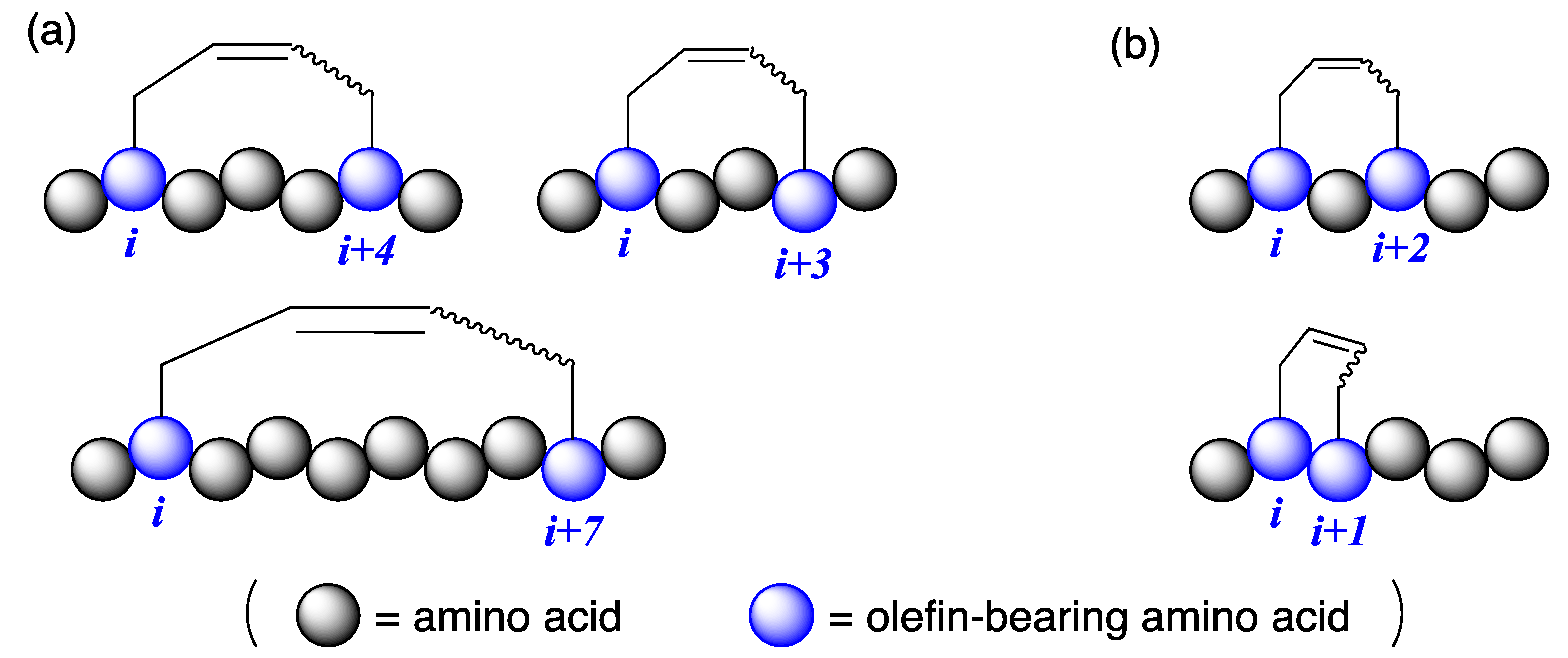
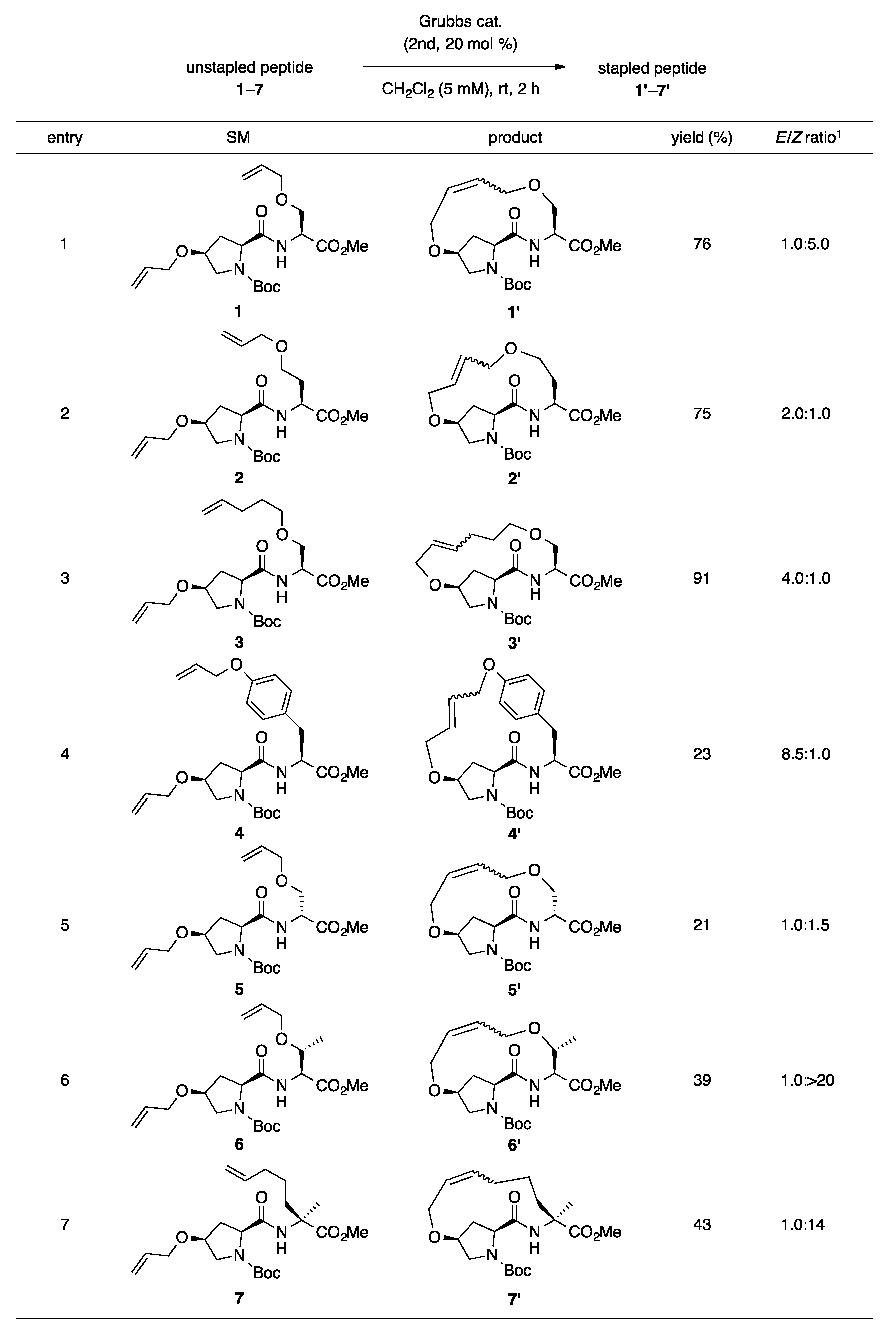
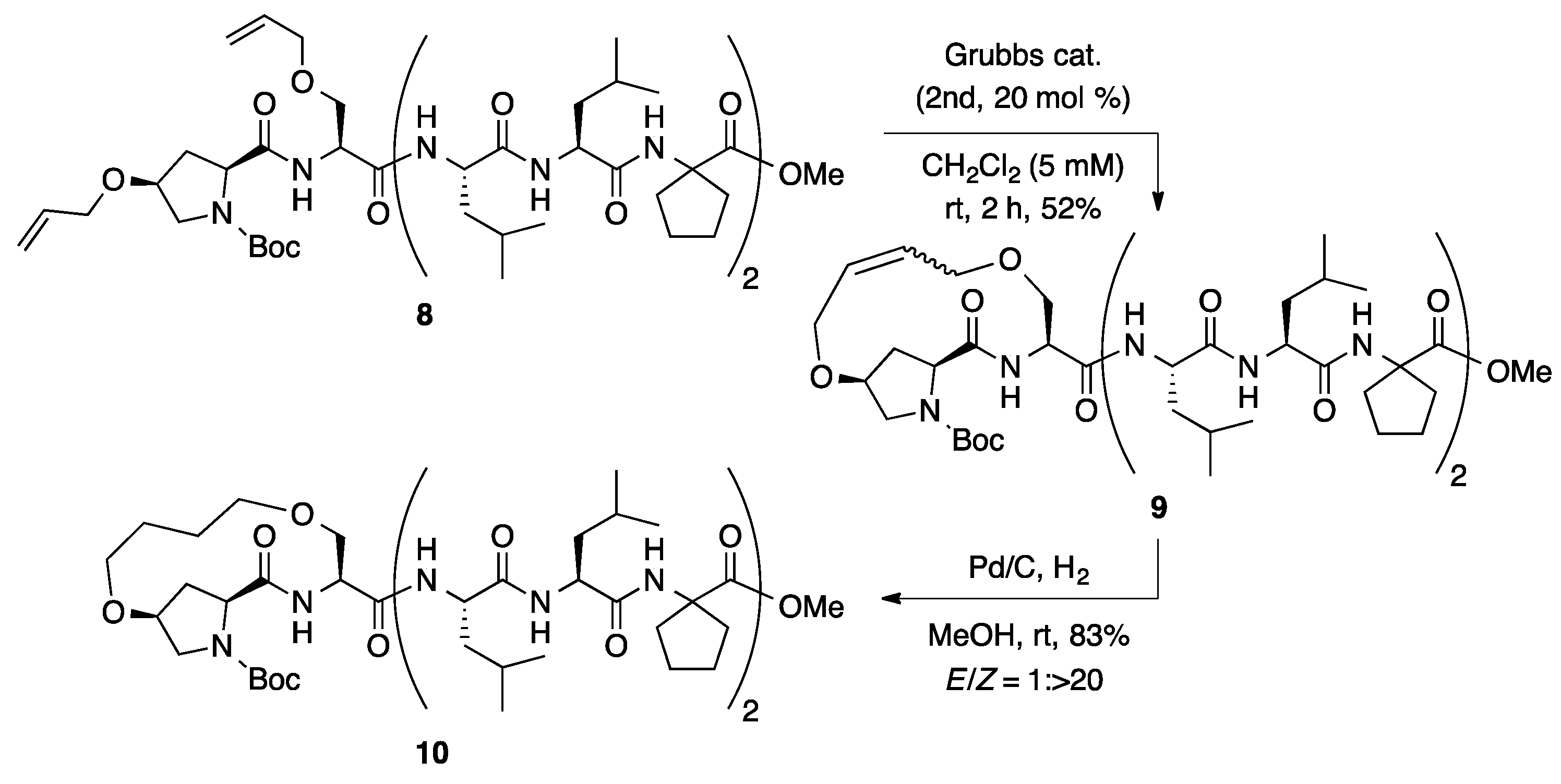
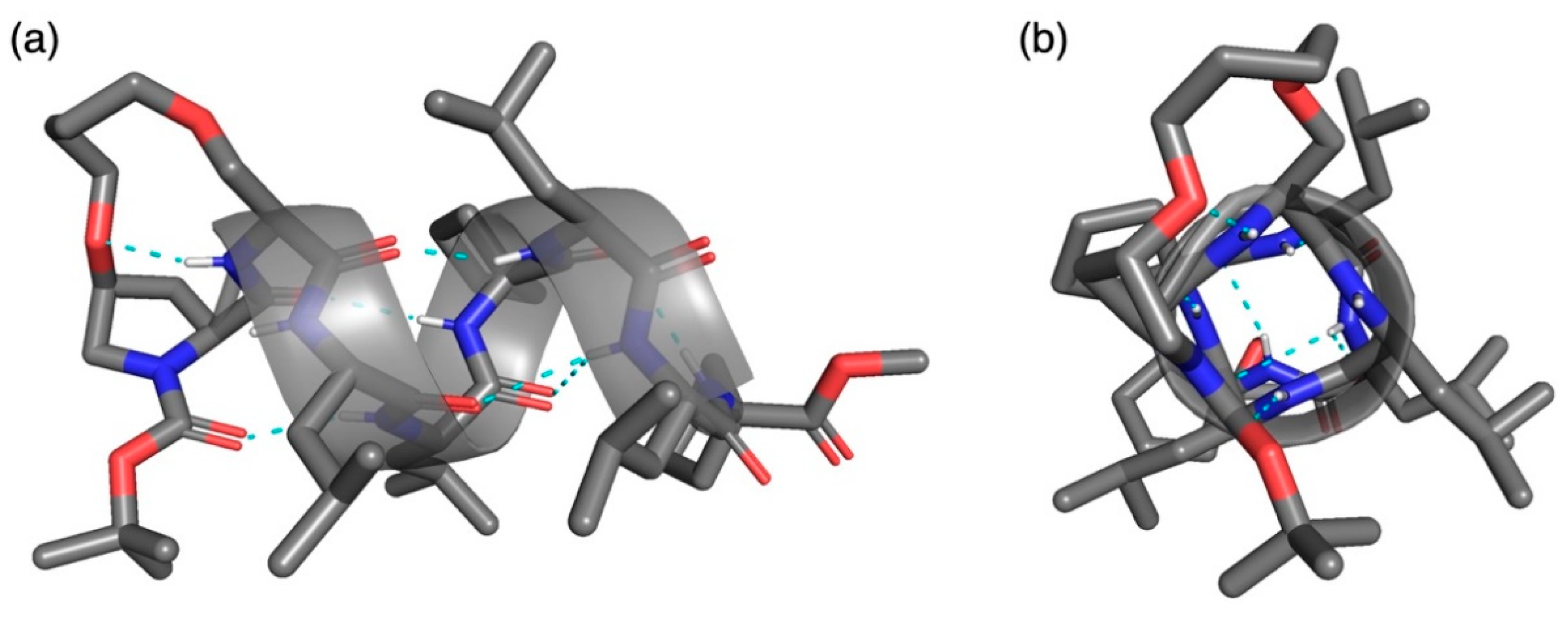

| Entry 1 | Catalyst (mol %) | Solvent (mM) | Temp. (°C) | Time (h) | Yield (%) | E/Z Ratio 2 |
|---|---|---|---|---|---|---|
| 1 | Grubbs 2nd (20) | CH2Cl2 (20) | rt | 2 | 55 | 1.0:5.6 |
| 2 | Grubbs 1st (20) | CH2Cl2 (20) | rt | 2 | 53 | 1.0:4.8 |
| 3 | Grubbs 2nd (20) | toluene (20) | rt | 2 | 37 | 1.0:3.0 |
| 4 | Grubbs 2nd (20) | DCE (20) | rt | 2 | 39 | 1.0:4.8 |
| 5 | Grubbs 2nd (20) | THF (20) | rt | 2 | 27 | 1.0:4.4 |
| 6 | Grubbs 2nd (20) | CH2Cl2 (5) | rt | 2 | 76 | 1.0:5.0 |
| 7 | Grubbs 1st (20) | CH2Cl2 (5) | rt | 2 | 69 | 1.0:4.7 |
| 8 | Grubbs 2nd (20) | CH2Cl2 (5) | reflux | 2 | 28 | 1.0:4.9 |
| 9 | Grubbs 2nd (20) | CH2Cl2 (5) | reflux | 0.5 | 28 | 1.0:5.3 |
| Empirical Formula | C54 H92 N8 O13, C3 H7 N O |
|---|---|
| Formula weight | 1134.45 |
| Crystal dimensions (mm) | 0.403 × 0.275 × 0.250 |
| Data collection temp. (K) | 93 |
| Crystal system | orthorhombic |
| Lattice parameters | |
| a, b, c (Å) | 11.357, 19.104, 29.332 |
| α, β, γ (°) | 90, 90, 90 |
| V (Å3) | 6363.84 |
| Space group | P 21 21 21 |
| Z value | 4 |
| D calc (g/cm3) | 1.184 |
| μ (MoKα) (cm−1) | 0.692 |
| No. of variable | 765 |
| No. of observations | 11273 (I > 2δ(I)) |
| R1 (I > 2δ(I)) | 0.0275 |
| wR2 | 0.0707 |
| Crystallizing solvent | DMF/H2O |
| Donor D–H | Acceptor A | Distance [Å] D···A | Angle [°] D–H···A | Symmetry Operations |
|---|---|---|---|---|
| N4-H | O0 | 3.09 | 163.6 | x,y,z |
| N5-H | O1 | 2.98 | 168.6 | x,y,z |
| N6-H | O2 | 2.91 | 157.2 | x,y,z |
| N7-H | O3 | 3.14 | 139.7 | x,y,z |
| N7-H | O4 | 3.37 1 | 136.7 | x,y,z |
| N8-H | O4 | 3.23 | 102.9 2 | x,y,z |
| N8-H | O5 | 3.40 1 | 162.7 | x,y,z |
| N2-H | OHyp4 | 2.93 | 137.6 | x,y,z |
| N3-H | ODMF | 2.90 | 159.8 | 1/2–x,1–y,–1/2 + z |
Publisher’s Note: MDPI stays neutral with regard to jurisdictional claims in published maps and institutional affiliations. |
© 2021 by the authors. Licensee MDPI, Basel, Switzerland. This article is an open access article distributed under the terms and conditions of the Creative Commons Attribution (CC BY) license (https://creativecommons.org/licenses/by/4.0/).
Share and Cite
Makura, Y.; Ueda, A.; Kato, T.; Iyoshi, A.; Higuchi, M.; Doi, M.; Tanaka, M. X-ray Crystallographic Structure of α-Helical Peptide Stabilized by Hydrocarbon Stapling at i,i + 1 Positions. Int. J. Mol. Sci. 2021, 22, 5364. https://doi.org/10.3390/ijms22105364
Makura Y, Ueda A, Kato T, Iyoshi A, Higuchi M, Doi M, Tanaka M. X-ray Crystallographic Structure of α-Helical Peptide Stabilized by Hydrocarbon Stapling at i,i + 1 Positions. International Journal of Molecular Sciences. 2021; 22(10):5364. https://doi.org/10.3390/ijms22105364
Chicago/Turabian StyleMakura, Yui, Atsushi Ueda, Takuma Kato, Akihiro Iyoshi, Mei Higuchi, Mitsunobu Doi, and Masakazu Tanaka. 2021. "X-ray Crystallographic Structure of α-Helical Peptide Stabilized by Hydrocarbon Stapling at i,i + 1 Positions" International Journal of Molecular Sciences 22, no. 10: 5364. https://doi.org/10.3390/ijms22105364
APA StyleMakura, Y., Ueda, A., Kato, T., Iyoshi, A., Higuchi, M., Doi, M., & Tanaka, M. (2021). X-ray Crystallographic Structure of α-Helical Peptide Stabilized by Hydrocarbon Stapling at i,i + 1 Positions. International Journal of Molecular Sciences, 22(10), 5364. https://doi.org/10.3390/ijms22105364





